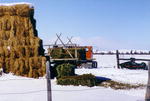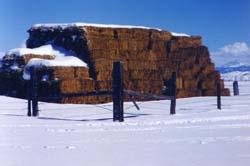|
THE HAYSTACK
A Timeshare in the Meadow
Our dogs always know what's living in the haystack
- that lonely port in a storm, which rises like a sentinel above the waves
of downy whiteness. In fact, the dogs know everything, long before we do
- long before we even pull up to the barbed-wire gate. And, while we have
come to know the different animal smells that coat the air around and within
a stack of hay, our dogs' keen noses have picked up the scent of a "hot"
trail before we can even zip up our coats in the morning. Usually, we can
predict how large or small the stack yard "boarder" is, by how
high the dogs jump, how many hair spike along their arched spines, and
by the pitch of the gargled warning in their throats.
Over the years, nearly all our ranch dogs long
for the winter's daily cow-feeding job, and with it - the "great hunt."
On the first day that the hayrack slips silently toward the meadow feedground,
the "hounds" cannot control their excitement as they race ahead
of us, then charge back, cutting furrows through the snow, and thrusting
sensitive noses deep into the powder. And, on each return circle, they
impatiently seem to wish we'd move along a bit faster.
Cleaning up a stack bottom, for the dogs at least,
is a task they'll wait for all week, because it is beneath that last mattress
of hay where lies the "cake's icing" - that moist and musty,
rich, black dirt left untouched by the frost of the season, but yet, holding
a maze of high-tech trenches molded to fit a mouse's body. As we tear each
bale from its resting place - irritated - we stumble over frenzied dogs,
rabid for the bone-crunching taste of mouse guts. But, they'll not be stopped
until the mouse hunt has yielded the very last rodent. 
We were still feeding with the pickup, before
it snowed up, when husband Rudy sweetly suggested to his wife, "Jump
in the pickup and pull out of the yard, and I'll shut the gate."
But, about that time, out of the corner of my
eye, I spotted a little survivor of the "hunt" as it threaded
its way through the snow, trying to return to its nest in the remaining
half-stack of hay. At first glance, I thought it was a wounded mouse, and
sickened by anything that suffers, I ordered the belching dog to finish
the job she'd begun. However, upon closer inspection, I discovered that
instead of a field mouse, the dark-brown creature was a skinny, little
shrew.
He wasn't hurt that I could notice, so I took
pity on him, called the bug-eyed dog off, and tried to scoop the little
fellow into my glove. When I bent over to lend a hand, he disappeared under
the pickup tire. I dropped to my knees and peered under the bumper. I could
see him burrowing his way between the tire treads, so I took hold of his
petite tail, my finger extended upward like I was hoisting a fancy cup
of tea. And then, I pulled. Nothing. I tugged gently once more. Still,
he wouldn't budge. I wasn't sure how, but I figured he must have bit a
jagged edge of rubber and was holding fast.
I felt awkward where I knelt, and could barely
reach the creature, so I slithered onto my stomach and pushed farther beneath
the pickup. Now, I had a microscopic view of the situation. Poor little
thing, I thought, as I pulled on his tail one more time and could then
see the problem. Like a kid's tongue on a cold car door, the shrew's nose
was frozen fast to the tire chain!
I took off my gloves and put my finger next to
his nose to thaw it out, but when I pulled on his tail again, he still
did not budge. This desperate situation demanded a creative and quick solution,
so I pulled myself along on my elbows until he and I were nose to nose.
By now, not knowing of the situation on the off-side
of the pickup, impatient husband dear walked back from the gate, and upon
seeing his wife's overshoes sticking out from beneath the pickup, he hollered,
"What the he-- are you doing under there, Ma! Let's go!"
Not one to be distracted in the middle of a project,
I ignored his mutterings and hollered back. "Just give me a second.
I'm blowing hot breath on a shrew's nose."
"Oh for hell's sake!" Husband slapped
at the air.
The hot air didn't work as I'd hoped, so I was
left with no choice but to pull on his tail - just a little harder. I could
feel the sliver of tail stretch like a rubber band while the bitsy joints
popped soundlessly, but dangerously. Then - ploop. Something came loose.
His body was still intact, but on closer inspection, I could see that all
the fur and a skim of flesh would be riding home on the tire chain.
I carried the shrew to a hole between two bales
and held him toward it. He leapt nimbly into the blackness and was gone.
I've since discovered from Neighbor John Neely
that the bite from a shrew is quite poisonous to a mouse.
Each day - from autumn until spring - brings a
new set of tracks to the haystack. After the mice (and shrews) move in
and the skunks plot their hibernation, the fox also might choose to make
reservations. He'll push his skinny body into the knife-blade shaped slits,
which slice up and down the pyramid-shaped fortress, then he'll commute
all winter, hunting mice, rabbits, and later, when spring arrives, they'll
feast on a smorgasbord of Canada Geese and their eggs as they nest on the
topmost deck. Once in a while, too, we'll catch sight of a coyote on the
bale roof, "catching" a quick bite, sunning himself, or simply
surveying his territory from his lofty perch.
Moose, typically, can be a stack's best customer
as they stumble and fumble through and over the barbed-wire containment.
But, if the type of hay is not to their liking, they'll just nibble, fuss,
and stir in their food, then take a nap before continuing on their tour
of the valley in search of a better Bed-and-Breakfast. We fence off any
hay - clover and timothy - that they are especially fond of - sort of put
out the "No Vacancy" sign.
Husband Rudy remembers another time when a woodchuck
had checked into a stack on Horse Creek and, unannounced, had curled up
and slipped into a deep winter's sleep. As the bale bucking effort ensued,
the ruff went up on the dogs' backs and a warning rumble rolled from O-shaped
dog mouths. When Rudy turned the next bale over like a thin-shelled egg,
instead of the skunk he'd expected to find, there, tucked to the chin in
warmth and dreams of summer, was a woodchuck.
The stack was being cleaned up that day, and since
the groundhog-like animal was remaining groggy, Rudy felt sorry for him
and decided to put the chubby, little, sorrel-colored character into the
passenger hole of the snowcat.
By design, the snowcat provides a bouncy, gassy,
less than comfortable or quiet ride. So, while homeward bound, with the
rumbling, rocking, and rolling motion juggling the heat, from the engine
into the cab, a great thawing occurred, and the sweetly sleeping woodchuck
was transformed into a scared and half-cranky ball of flaming fur.
But with the leg area below the seat being straight-edged,
slick, and deep, "Chucky" couldn't escape, so he hid under the
seat and periodically barked a sharp, "Sic, sic!" warning.
When Rudy pulled into the ranch yard, he laughed
and encouraged me to "get right in there, Ma, and look under the Cat
seat" at the cranky passenger. He then grabbed a pair of thick welding
gloves, dragged the creature from the Cat, and set him free under the old
homestead building. (The following summer, the woodchuck whistled in a
wife, had many children, and to this day, still "lives" with
us, taunting and tormenting the dog herd.)
For many years, now, raccoons have lurked about
the barnyard and have become notorious at stripping newborn kittens right
out of their fur jackets, then feast upon the tender flesh. Therefore,
come late spring, some of the barn cats will head for the meadow to give
birth to their kittens in the peace and quiet of the nearest haystack.
Then one by one, the mother cat will latch on to, and laboriously carry
each one back to the hayloft, hopeful that we've discouraged the naughty
bandits, even for a while. Ironically, we've even found raccoon nests and
newborn babies in the haystacks, then had to decide what to do with the
helpless, little mouse-like creatures. One year, after we had talked Bucky
and Lucy Neely into taking three of them, the late Dr. Bert Reinow, DVM,
gave us a very educational tip: Beware. The nesting material of raccoons
harbors bacteria, which can be deadly to children.
Today, two of our veteran "hunters"
are too old to follow along to the Horse Creek feedground (they refuse
to ride in the snowcat), and because the new pups are still too young,
we travel alone each day to feed, not knowing what we'll "turn-up"
in the hay pile. Just yesterday, we picked up a bale and awakened not a
single or even a double occupancy, but rather, a family of six skunks.
A hint of "perfume" lingered on the breeze as they lumbered sleepily
up the steps of bales, onto the next "floor", only to disappear
into a crack in the hay. I'm sure, we'll be issuing the little family a
wake-up call again, very soon.
I miss our "hunters", and can hardly
wait until the new pups will pick up the scent of the haystack.
|

